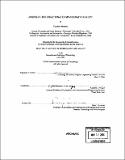| dc.contributor.advisor | Annalisa L. Weigel. | en_US |
| dc.contributor.author | Mathieu, Charlotte | en_US |
| dc.contributor.other | Massachusetts Institute of Technology. Technology and Policy Program. | en_US |
| dc.date.accessioned | 2006-11-07T12:44:03Z | |
| dc.date.available | 2006-11-07T12:44:03Z | |
| dc.date.copyright | 2006 | en_US |
| dc.date.issued | 2006 | en_US |
| dc.identifier.uri | http://hdl.handle.net/1721.1/34522 | |
| dc.description | Thesis (S.M.)--Massachusetts Institute of Technology, Engineering Systems Division, Technology and Policy Program, 2006. | en_US |
| dc.description | Includes bibliographical references (leaves 139-141). | en_US |
| dc.description.abstract | In the traditional approach, spacecraft are tailored to each mission and are associated with high risks and costs and long cycles. Moreover, once launched, their flexibility remains limited. The concept of spacecraft fractionation could enable manufacturers and users to decrease these risks and costs and to increase space systems flexibility. Fractionation transforms the traditional monolithic spacecraft into a network of elements: a free-flying payload module is supported by free-flying modules that provide the payload with power, communications, etc. Thus modules could be maintained, exchanged, and reused once launched. Furthermore one could imagine developing a whole on-orbit infrastructure made of standardized modules that could support different payloads. This thesis investigates under what conditions fractionated spacecraft could be worthwhile alternatives to traditional ones. The first part assesses different fractionated architectures and compares them with traditional ones in terms of utility and cost for a given mission and given level of performance. A framework based on Multi-Attribute Tradespace Exploration was used to analyze the impact of fractionation, first at spacecraft level for a single mission, and second, at infrastructure level, when the spacecraft is part of the infrastructure. | en_US |
| dc.description.abstract | (cont.) The study demonstrates that if space assets flexibility is valued enough, customers would choose fractionated spacecraft over traditional ones. The second part of the thesis examines the impact of spacecraft fractionation on the aerospace industry to understand why despite so many potential benefits, there are major barriers that prevent its implementation. Such an innovative concept could actually create a whole new paradigm in which today's protoflight approach would become a mass production approach, which would bring sweeping changes in today's space industry organization. This thesis explores policy options to increase the private sector's ability and motivation to implement fractionation and makes specific recommendations to enable the shift from today's paradigm to the fractionated spacecraft paradigm. | en_US |
| dc.description.statementofresponsibility | by Charlotte Mathieu. | en_US |
| dc.format.extent | 149 leaves | en_US |
| dc.format.extent | 9765684 bytes | |
| dc.format.extent | 9773716 bytes | |
| dc.format.mimetype | application/pdf | |
| dc.format.mimetype | application/pdf | |
| dc.language.iso | eng | en_US |
| dc.publisher | Massachusetts Institute of Technology | en_US |
| dc.rights | M.I.T. theses are protected by copyright. They may be viewed from this source for any purpose, but reproduction or distribution in any format is prohibited without written permission. See provided URL for inquiries about permission. | en_US |
| dc.rights.uri | http://dspace.mit.edu/handle/1721.1/7582 | |
| dc.subject | Technology and Policy Program. | en_US |
| dc.title | Assessing the fractionated spacecraft concept | en_US |
| dc.type | Thesis | en_US |
| dc.description.degree | S.M. | en_US |
| dc.contributor.department | Massachusetts Institute of Technology. Engineering Systems Division | |
| dc.contributor.department | Technology and Policy Program | |
| dc.identifier.oclc | 70901841 | en_US |
